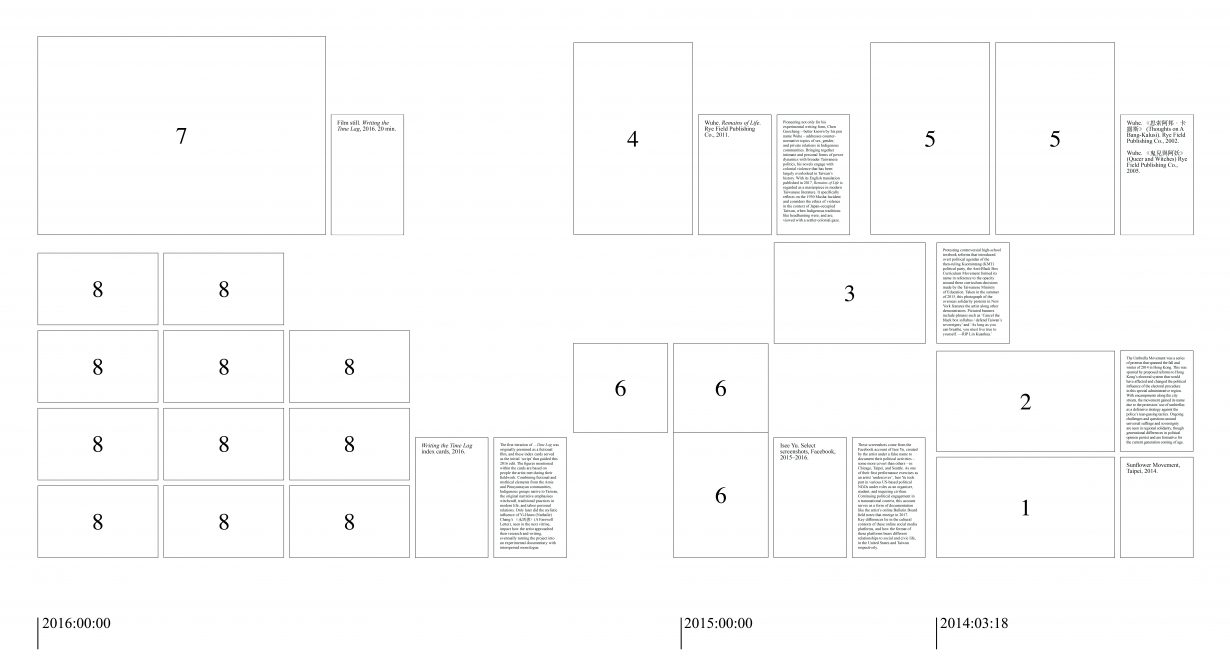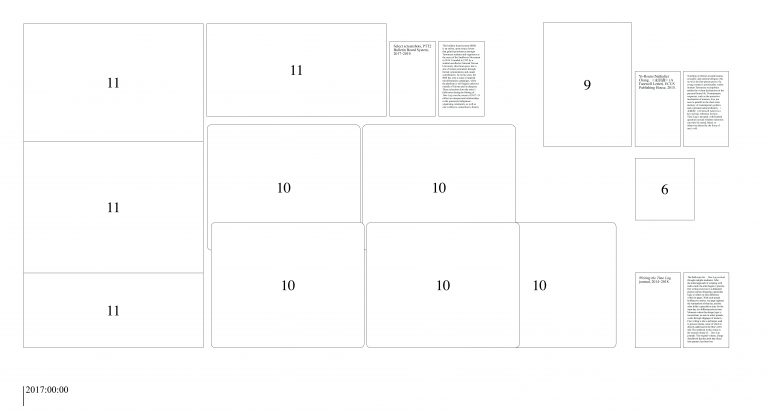Rachel Be-Yun Wang provides an entry point into the ongoing process of Lee Tzu Tung’s experimental documentary Writing the Time Lag (2014–)

An assemblage of documentary shots, home footage, interview clips and found television broadcasts, Writing the Time Lag (2014–), a videowork by Taiwanese artist and director Lee Tzu Tung, centres on the experiences of those involved in Taiwan’s grassroots Indigenous activism community. It’s an experimental documentary, informed by an ethnographic approach to collaborative and participatory filmmaking. Within that, activist voices and political narratives shape what the artist calls a ‘microcosm of Taiwan’s complex identity dynamics’.
These stories are woven together by Lee’s intervention into the documentary form, which directly discusses the different stages of production within the documentary. Since starting this project, the artist has re-edited the piece approximately every two years, to include updated recordings while incorporating the screen-recorded postproduction process into the video footage itself. Their reflexive method foregrounds an authorial subjectivity, revealing changing perspectives over time and foregrounding a multilayered approach to documenting the experience of history within individuals.
Organised on a timeline across the three display cases, film stills from Writing the Time Lag’s 2021, 2018 and 2016 iterations are interspersed with Lee’s field notes and literary influences across this period. As part of ‘A Diachronic Record’, this article highlights selections from the vitrine display at the Asymmetry Art Foundation, and provides an entry point into the ongoing process of this experimental documentary. While the video itself is an archive, this display further evidences its process and provides insight into the primary-source research of the project. The artist’s varied approach to their field notes – whether they take the form of index cards, notebooks, online bulletin boards or postings on a private Facebook account – reflects the different stages and geographies of this project’s expansion. The following selections of materials draw connections to the literary world through the works of Wuhe and Yi-Hsum (Nathalie) Chang, while other materials like forum postings and street photographs evidence how Taiwan’s organising communities build transnational solidarities beyond traditional notions of borders and mapping.
The end of the timeline is where we are today; reflecting over the past decade, Lee leaves us with a new index card that speaks to seeing the other side of the moon. Despite the structural realities embedded in their work, their comments are not an attempt at diagnosing society. Rather, these are annotations that tune into the different types of belonging that one can carry between worlds.

2014:03:18
1 – The Sunflower Movement, Taipei
2 – Umbrella Movement, Hong Kong, 2014
The Umbrella Movement was a series of protests that spanned the fall and winter of 2014 in Hong Kong. This was spurred by proposed reforms to Hong Kong’s electoral system that would have affected and changed the political influence of the electoral procedure in this special administrative region. With encampments along the city streets, the movement gained its name due to the protesters’ use of umbrellas as a defensive strategy against the police’s teargassing tactics. Ongoing challenges and questions around universal suffrage and sovereignty are seen in regional solidarity, though generational differences in political opinion persist and are formative for the current generation coming of age.
3 – Anti-Black Box Curriculum Movement, New York City, 2015
Protesting controversial high-school textbook reforms that introduced overt political agendas of the then-ruling Kuomintang (KMT) political party, the Anti-Black Box Curriculum Movement formed its name in reference to the opacity around these curriculum decisions made by the Taiwanese Ministry of Education. Taken in the summer of 2015, this photograph of the overseas solidarity protests in New York features the artist along with other demonstrators. Pictured banners include phrases such as ‘Cancel the black box syllabus / defend Taiwan’s sovereignty’ and ‘As long as you can breathe, you must live true to yourself. – RIP Lin Kuanhua’.
4 – Wuhe. Remains of Life. Rye Field Publishing Co., 2000
Pioneering not only for his experimental writing form, Chen Guocheng – better known by his pen name Wuhe – addresses counternormative topics of sex, gender and private relations in Indigenous communities. Bringing together intimate and personal forms of power dynamics with broader Taiwanese politics, his novels engage with colonial violence that has been largely overlooked in Taiwan’s history. With its English translation published in 2017, Remains of Life is regarded as a masterpiece in modern Taiwanese literature. It specifically reflects on the 1930 Musha Incident and considers the ethics of violence in the context of Japan-occupied Taiwan, when Indigenous traditions like headhunting were, and are, viewed with a settler-colonial gaze.
5 – Wuhe. 《思索阿邦.卡露斯》 (Thoughts on A Bang-Kalusi). Rye Field Publishing Co., 2002
Wuhe. 《鬼兒與阿妖》(Queer and Witches). Rye Field Publishing Co., 2005
2015:00:00
6 – Isee Yu. Select screenshots, Facebook, 2015–16
These screenshots come from the Facebook account of Isee Yu, created by the artist under a false name to document their political activities – some more covert than others – in Chicago, Taipei and Seattle. As one of their first performance exercises as an artist ‘undercover’, Isee Yu took part in various US-based political NGOs under roles as an organiser, student and inquiring civilian. Continuing political engagement in a transnational context, this account serves as a form of documentation like the artist’s online Bulletin Board field notes that emerge in 2017. Key differences lie in the cultural contexts of these online social media platforms, and how the format of these platforms bears different relationships to social and civic life, in the United States and Taiwan respectively.
2016:00:00
7 – Writing the Time Lag film still, 2016. 20 min

8 – Writing the Time Lag index cards, 2016
The first iteration of Writing the Time Lag was originally premised as a fictional film, and these index cards served as the initial ‘script’ that guided this 2016 edit. The figures mentioned within the cards are based on people the artist met during their fieldwork. Combining fictional and mythical elements from the Amis and Pinuyumayan communities, Indigenous groups native to Taiwan, the original narrative emphasises witchcraft, traditional practices in modern life and taboo personal relations. Only later did the stylistic influence of Yi-Hsum (Nathalie) Chang’s 《永別書》(A Farewell Letter), seen in the next vitrine, impact how the artist approached their research and writing, eventually turning the project into an experimental documentary with interspersed monologue.

9 – Yi-Hsum (Nathalie) Chang. 《永別書》(A Farewell Letter). ECUS Publishing House, 2015
Touching on themes around trauma, sexuality and national allegory, this novel is the first-person prose of a young woman’s positionality within modern Taiwanese sociopolitics amid the violent dysfunction of her personal home life. Posttraumatic responses, such as the protective mechanism of memory loss, are seen in parallel to the short-term memory of contemporary politics and contested national identity. 《永別書》(A Farewell Letter) is a key stylistic reference for how Writing the Time Lag is narrated, with kindred questions around whether memories can truly be erased, faked or otherwise altered by the force of one’s will.

10 – Writing the Time Lag journal, 2014–18
The field notes for Writing the Time Lag evolved through multiple mediums. After the initial approach of scripting with index cards, the artist began to practise free writing exercises in a dedicated project journal, designing a particular logic to reflect on time difference within its pages. With each spread holding two entries, one page captures the ruminations of that day, and the other holds a speculative entry for the same day at a different point in time. Moments where this design logic is inconsistent, as seen in select spreads, works through slippages of memory. Free writing is also a technique used to process trauma, some of which is directly addressed in the film’s 2021 edit. The notebook in this vitrine is the second volume of Writing the Time Lag journals. The original volume, a large sketchbook that the artist had sliced into quarters, has been lost.
2017:00:00
11 – Select screenshots, PTT2 Bulletin Board System
This bulletin board system (BBS) is an online, open-source forum that gained prominence among Taiwanese students and organisers at the onset of the Sunflower Movement in 2014. Founded in 1995 by a student enrolled at National Taiwan University, this forum grew into a site of citizen journalism through formal commentaries and casual contributions. In recent years, the BBS has seen a surge in targeted misinformation campaigns, while the platform is still largely unknown outside of Taiwan and its diaspora. These selections from the artist’s field notes during the filming of Writing the Time Lag over the course of 2017–19 reflect on interpersonal relationships in the grassroots Indigenous organising community, as well as one’s reflexive connection to history.

2018:00:00
12 – Writing the Time Lag film still, 2018. 50 min
13 – Select screenshots, PTT2 Bulletin Board System
2019:00:00
14 – Select screenshot, PTT2 Bulletin Board System

2021:00:00
15 – Writing the Time Lag film stills, 2021. 72 min
2024:00:00
16 – Writing the Time Lag index card, 2024
Explore the full vitrine:
3 images



ArtReview is partnering with Asymmetry to publish a series of cultural reflections by the foundation’s fellows